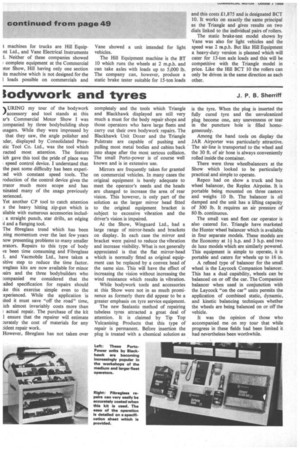Static brake testers A. J. P. Wildii W HEN the annual
Page 51

Page 52

If you've noticed an error in this article please click here to report it so we can fix it.
tests of commercial vehicles become effective, operators are going to have to send their vehicles to Ministry of Transport testing stations for the check which will decide whether the vehicle needs attention if it is to be used on the road. The main point that will be checked is brakes and all trucks will need to meet prescribed efficiencies with correct balance and so on.
One way that brake characteristics can be ascertained is by using static brake testers. With these, the wheels are driven by rollers and the braking effort that is applied at the wheels can be found. The main advantages in using static brake-test equipment is that the job of testing is much safer and that there is not the problem of finding suitable and dry roads that the more usual type of testing would require.
With the Ministry of Transport using static brake-test equipment operators will be interested to know how these units work and there will be a few who will find it worthwhile to install this type of equipment even though the cost can be fairly high. With these points in mind I decided to take a look around the "gallery" at Earls Court to see what is available.
There were four exhibitors offering these units and of them, Triangle Products Ltd., is probably the most advanced in sales in this country. The concern offers its Dynamic Brake Tester and a lot of interest has been shown by prospective users. Seven have already been installed in garages or at operators' premises and the model works like all units of the same type.
There are two pairs of rollers on which the wheels rest and these are driven by electric motors at a slow speed. When the vehicle brakes are applied the amount of effort at the wheels is recorded on dials and in the case of a Triangle model a special slide rule supplied with the machine is used to calculate the overall efficiency of the brakes; the variation in efficiency between the wheels shows up any lack of balance in the brakes.
An evaluation of the Triangle Brake Tester was published in COMMERCIAL MOTOR of June 10 and the efficiency recorded with the unit was found to be very close to that obtained on a normal-type road test at 30 m.p.h. The machine also showed up defects in the brake system. The rollers are driven by 5 h.p. electric motors at 5 m.p.h. and the model can accommodate axles up to the maximum legal width and loads up to 10 tons. The rollers can be driven in opposite directions to accommodate axles of double-drive bogies without a third differential in the drive between the axles. The machine costs £1,950 but it can be obtained on a five-year lease when the
cost is £47 2s. 9d. a month which wo out at £6 12s. a week taking into acco tax allowances.
The commercial vehicle brake tester m keted by Kismet Ltd. is the Kismet-H: KBT 1100 which is imported from H. Andersson of Copenhagen. More than of the models are reported to be in throughout Europe and loads of up to tons can be accommodated. The mach operates in the same way as the Trian but the rollers are driven at 1.25 m.1 by two 15 h.p. motors and they cannot made to go in opposite directions. Sim information to the Triangle is given instead of a combined scale there are t pairs of dials linked to the individual roll, one being for heavy vehicles and the ot for light vans and so on.
An extra item is equipment which 4 measure the lag in brake application z instead of this a graph of the brake char teristics can be obtained with optio equipment available. The KBT 1100 cc £2,950 and the unit can be supplied m equipment to drive the wheels at a fa. speed if desired.
The other two companies offering.bn
t machines for trucks are Hill Equipnt Ltd., and Vane Electrical Instruments 1. Neither of these companies showed : complete equipment at the Commercial kor Show, Hill having only one section its machine which is not designed for the I loads possible on commercials and Vane showed a unit intended for light vehicles.
The Hill Equipment machine is the BT 10 which runs the wheels at 2 m.p.h. and can take axles with loads up to 5,000 lb. The company can, however, produce a static brake tester suitable for 15-ton loads and this costs £1,875 and is designated BCT 10. It works on exactly the same principal as the Triangle and gives results on two dials linked to the individual pairs of rollers.
The static brake-test model shown by Vane was also for light vehicles and the speed was 2 m.p.h. But like Hill Equipment a heavy-duty version is planned which will cater for 13-ton axle loads and this will be competitive with the Triangle model in price. Like the Hill BCT 10 the rollers can only be driven in the same direction as each other.




















































































































